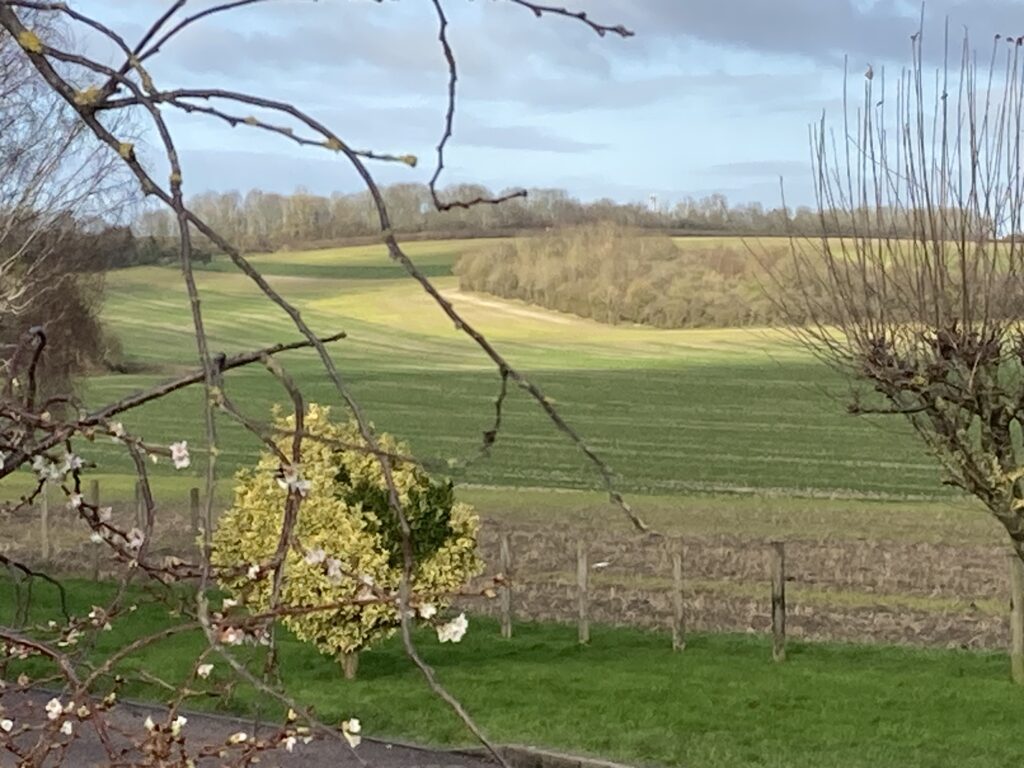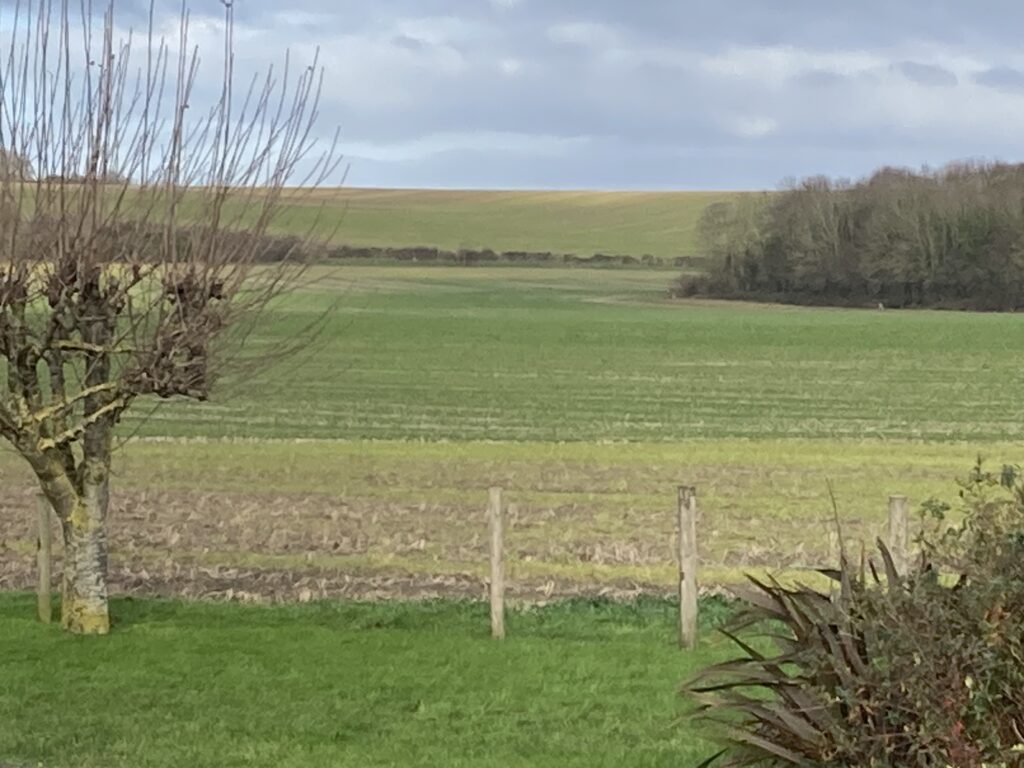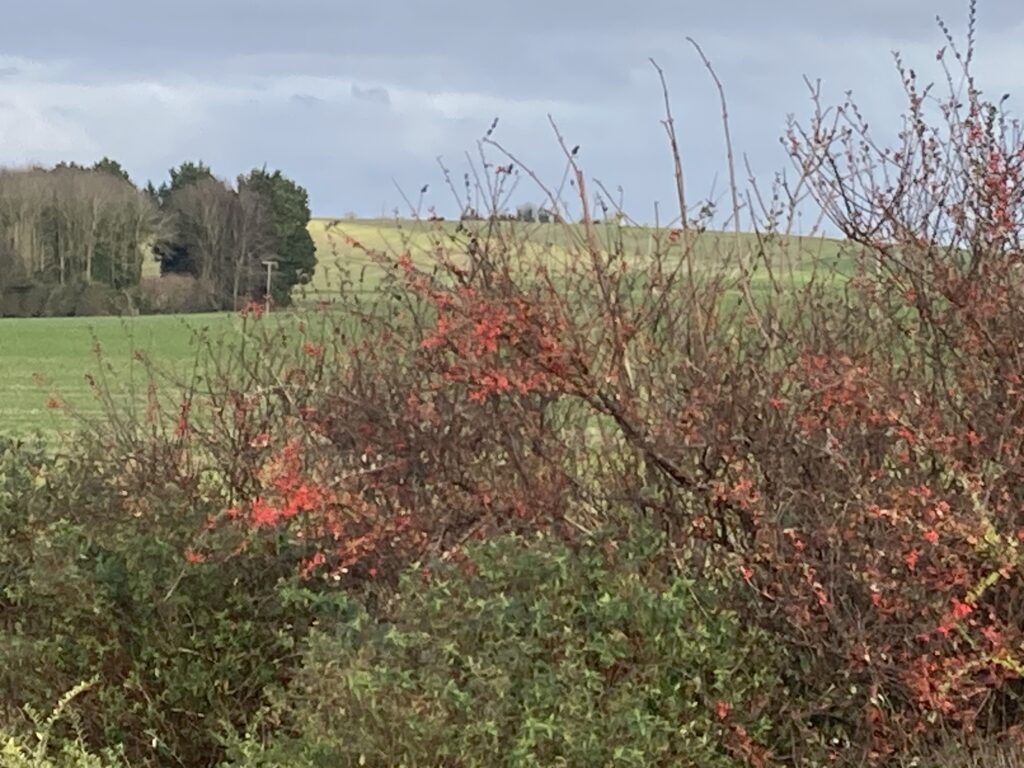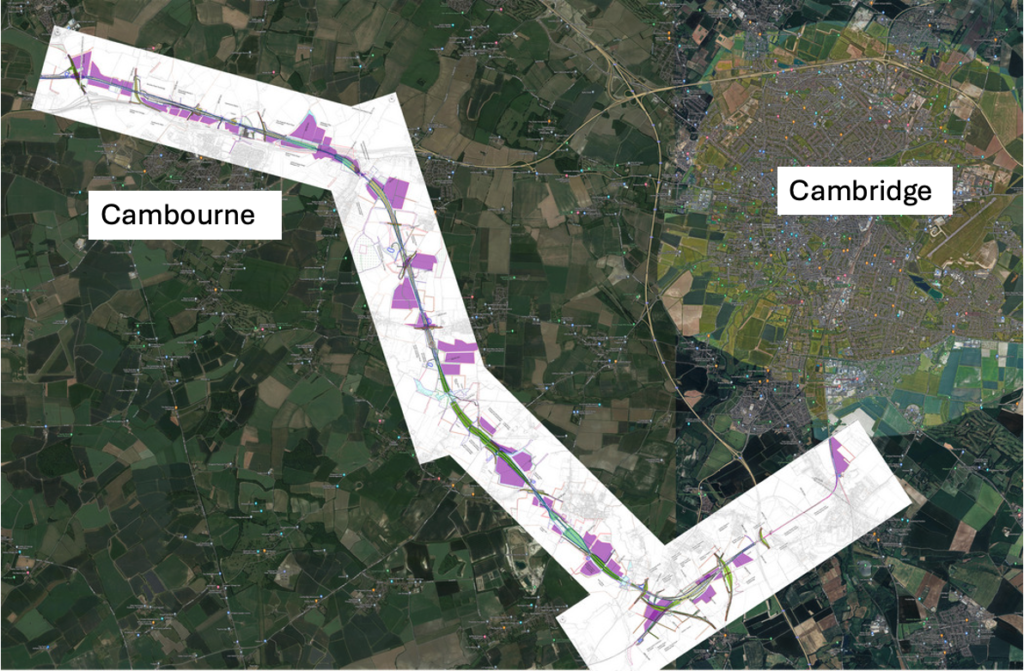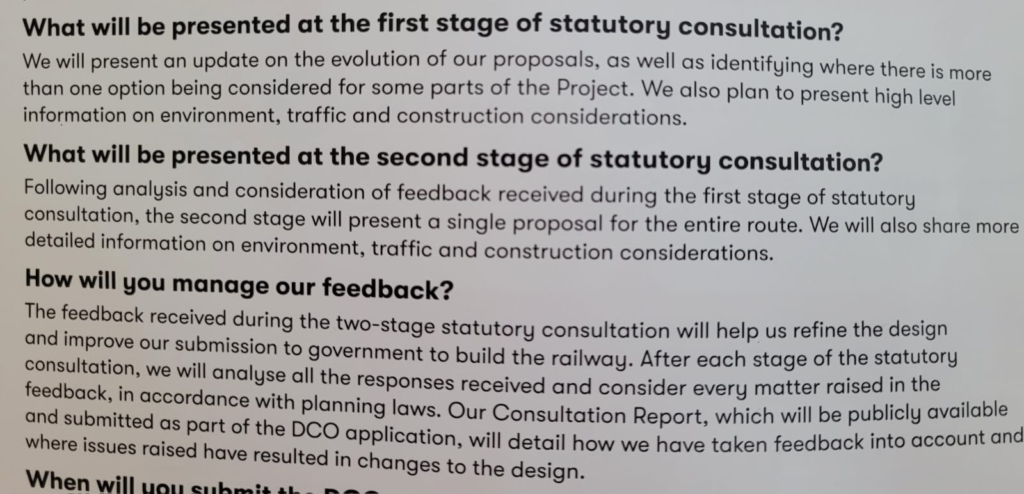A turnback near Little Shelford would provide greater benefits to the project
In this blog we look at whether a Northern Approach could serve all three Cambridge stations (North, ‘Central’ and South) and so improve any economic benefits there are for the project.
East West Rail Company (EWR Co) have repeatedly claimed that passengers approaching Cambridge on a Northern Approach would need to change at Cambridge Central to get to Cambridge South. This change, they say, would hinder the economic growth of Cambridge Biomedical Campus as it increases commuting time between affordable housing and jobs.
What we show below is that a Northern Approach would directly serve all three Cambridge stations with the simple addition of a turnback[1] facility beyond Cambridge South, near Little Shelford.
Meanwhile the latest consultation, in November 2024, admits that a Southern Approach would only serve two Cambridge stations (Cambridge South and Cambridge Central but not Cambridge North).
This blog has not been written to score points from EWR Co in the North vs South Approach debate but to offer a solution for their consideration. We believe that this option, by significantly increasing the benefits of the project, would greatly improve the strategic and financial business cases. It would do this even if they stopped their current surveys for a Southern Route.
[1] An empty length of track which a train can be driven into, and ‘reversed’ from, to change its direction of travel. Required beyond, or at, any terminal station.


Northern and Southern Approaches. Note the number of stations connected by each option. Northstowe station is an option for the Northern Approach.
Why is this so important?
EWR Co’s claim is critical because it forms the cornerstone of their argument that a Southern Approach is superior. They claim that only a Southern Approach could serve the Cambridge Biomedical Campus (CBC) directly without requiring a train change. Linking the CBC with affordable housing is, they say, key to unlocking transformational growth in the region.
While we totally reject the premise that any railway linking Oxford and Cambridge would transform the local economy, it is clear that a railway approaching from the north would provide better connectivity between housing and employment sites than one from the south, not only because it would connect directly to three Cambridge stations rather than two, but also because it would include in its catchment already Permitted Developments such as Northstowe. Consequently, any economic benefits from the project would be magnified by stopping at Cambridge North with its proximity to science parks which primarily serve the same sectors that the government is keen to promote (life sciences and information technology).
There are obviously other factors to consider in selecting the preferred option for the route, especially cost, construction time and environmental damage. While this article is not intended to address these points in detail, it is important to briefly consider them in order to provide context for the choice. EWR Co state:
‘Our high-level investigations since the 2021 consultation indicate that a northern approach may potentially be cheaper to build and quicker to construct, and have less potential environment impact, …’
Route Update Announcement 2023, Route Update Report, Ch. 7, ‘Confirming our preference for the southern approach’
See also the more specific statements made in a document only recently revealed by EWR Co (and only when ordered to do so by the Information Commissioner’s Office under the Freedom of Information Act), namely version v03 of the “Affordable Connections Project” report and its appendices, which we will comment on in detail later in the year. Its Executive Summary includes such misleading statements as (1.4.9):
‘Routes into Cambridge from the south provide direct access to the biomedical campus and the Astra Zeneca site via the proposed Cambridge South station. Routes into the city from the north provide good access to Cambridge Science Park (via Cambridge North station) but serve the biomedical campus less well.‘
This labours under the delusion that trains from the north cannot travel directly to Cambridge South.
In the interest of balance, we should point out that our northern route solution would narrow the cost and construction time differences between the approaches. This is mainly because the track between Cambridge and Shepreth Junction would likely need to be 4-tracked, as it is for the Southern Approach. However, the remaining differentiating factors for cost and construction time (such as the magnitude of new infrastructure required, including embankments, cuttings, tunnels, bridges and proximity to residential property) still strongly favour the Northern Approach. And it remains a less damaging alternative environmentally. It also largely avoids two entirely foreseeable and unresolved major areas of difficulty for EWR Co – the potential impact of construction and operation of a southern approach on the precious barbastelle maternity roost in the Eversden and Wimpole Woods SAC and its surrounding core sustenance zone and separately on the world-class Mullard Radio Astronomical Observatory (see Cambridge University’s response of 24 January to EWR Co’s recent consultation).
EWR Co’s claims in detail
Below are extracts from a sample of reports that EWR Co published during the 2023 Route Update Announcement, thought to be [2] the last time EWR Co assessed the route options into Cambridge (with my emphasis):
Reference 1
‘We considered whether it would be possible to serve Cambridge South station taking the Northern Approach but concluded that this would reduce the frequency of trains and extend journey times, including likely requiring passengers to change trains, to an unacceptable level. It would make it harder for people living in Bedford, the Marston Vale or near St Neots/Tempsford to access the jobs at the Biomedical Campus – and therefore it wouldn’t deliver the economic opportunity that underpins the case for EWR.’
Route Update Announcement 2023, Route Update Report, Ch. 1, ‘Connecting more people with opportunities in Cambridge’
Reference 2
‘8.3.30 … Whilst there is better accessibility for journeys through Cambridge from the North to the Cambridge Biomedical Campus this is not likely to be an available option in infrastructure terms. This is because if a Northern Approach were to be selected, EWR services would not be able to serve Cambridge South directly, which is situated adjacent to the Biomedical Campus. The location that is heavily constrained, with the Biomedical Campus to the east side and Hobson’s Park to the west side. To achieve direct connectivity for EWR trains from a NATC, infrastructure upgrades would be needed on the WAML south of Cambridge station to enable EWR trains to run through to Cambridge South station, or significant changes to existing services would be needed – this is described below.
8.3.31 This means that all EWR services would have to terminate at Cambridge station and would require passengers to change trains to complete their journeys, introducing an interchange penalty for passengers:
- It would significantly increase the journey time to Cambridge South compared to a southern approach. For example, from the new EWR station at Tempsford/St. Neots, the journey time would nearly double from an estimated 21 minutes via a Southern Approach to at least 39 minutes using a northern approach. The estimated journey time from Bedford would increase from 32 minutes to over 50 minutes.’
Route Update Announcement 2023, Economic and Technical Report, Ch.8 ‘Identifying a Single Preferred Route between Bedford and Cambridge’
Reference 3
‘We have considered how the revised Northern Approach and Southern Approach to Cambridge performed in terms of short distance connectivity to support commuting travel into key employment hubs. Both routes would provide direct connectivity between housing centres and employment hubs. …
‘The need for passengers [approaching from the north] to change trains to access Cambridge South would cause greater inconvenience and mean that journey times are further extended compared to the Southern Approach to Cambridge.
‘By comparison, EWR trains using a Southern Approach could be extended to Cambridge North station – calling at all three stations in the Cambridge built-up area – subject to relatively minor upgrades to the track and platforms at and near the current station.’
2021 Consultation Feedback Report: Ch.3 The approach to Cambridge, 3.2.9
These extracts clearly demonstrate EWR Co was claiming that a Northern Approach would require changing trains at Cambridge station to access Cambridge South station. Interestingly, the last extract states that a Southern Approach could call at all three Cambridge stations: this has been shown not to be the case in the 2024 Non-statutory Consultation with the introduction of the Cherry Hinton turnback facility.
[2] That is, until their forced revelation of the ACP Report and Appendices
Feasibility
How are we so sure that a Northern approach could serve Cambridge South when EWR Co say that passengers need to change trains?
While there are a number of options for the location of the turnback (including on the West Anglia Main Line), we have considered a location south of Cambridge South station near Little Shelford to demonstrate feasibility. Other locations can be reviewed by EWR Co during their own feasibility design stage.
The turnback allows trains to park in a siding off the main line so that passing trains are not blocked. Passengers approaching from the north would alight at Cambridge South, the driver would drive the empty train to the turnback facility and ‘reverse’. In practical terms, reversing simply means that the train driver walks to the cab at the other end of the train to allow it to be driven back towards Bedford. Alternatively, a relief train driver could step straight into the cab at the Cambridge end of the train.
In their Affordable Connections Project report, which compared a number of route options, EWR Co considered a Northern Approach terminating at Cambridge South. This was rejected primarily on the grounds of affordability as, they say, it would require a grade-separated junction, four-tracking between Cambridge Central and Cambridge South, major works at Cambridge Central and Cambridge South stations, signalling and the cost of the turnback facility itself. There are no options presented with a turnback south of Cambridge South station. We offer no explanation why EWR Co have failed to mention our proposed solution. The figures below show our suggested location and indicative details of the turnback facility.


Satellite image of turnback location. Note line of trees to S of tracks
In our turnback layout, the siding is located between the main line tracks as indicated graphically below. This is to avoid conflicts of train movements which would occur if there were a siding to the side of the main lines. The bridge over the River Cam may need to be widened, depending on the length of sidings required. The new track would be on the east side of the existing line to avoid the scheduled monument on the west side. A narrow band (approximately 5-6m) of the existing wood may need to be cut back depending on the railway boundaries and detailed design. The facility would include a new train crew accommodation building providing messing, toilets, lockers and car parking for the train crews. A train crew walking route would incorporate a new footbridge over the main line and fencing between the walking route and the main line for safety reasons. Services for this facility including electricity, water and sewerage, would be accessed from the Hauxton Road. The turnback facility would be situated in a less built-up area than the one in Cherry Hinton (proposed by EWR Co for a southern approach) and so would have less impact on local residents. It would be largely hidden from residents’ houses by the existing band of trees along the length of the siding.

Indicative plan of turnback siding. Note central location of siding to avoid train movement conflicts

Looking E towards Cambridge from Hauxton Road level crossing. Note the thicket of trees on the R
The current proposal for a Southern Approach shows that EWR Co are currently considering this area for an infrastructure maintenance depot (see figure 149 of the 2024 Technical Report). If this site is selected, the development would be on an altogether different scale to a turnback facility. EWR Co’s Technical Report (14.6.2.1) describes an infrastructure maintenance depot: ‘This 24-hour facility would operate year-round and provide accommodation and welfare for up to 150 staff, parking, unloading areas and storage for spare parts, tools and materials. The IMD would consist of an office building of no more than two storeys, covered stores and outdoor storage for large equipment.’ This could take the entire field bounded by the rear gardens on Hauxton Road and Bridge Street, the railway line and Manor Farm.
Importantly, the turnback proposed by EWR Co at Cherry Hinton involves land-take from Coldham’s Common, a local nature reserve and a city wildlife site. Four EWR trains would pass the site in each direction during the day. Currently there is about one an hour in each direction. The exceptionally tight radius rail-track bend on the common would generate high volume wheel noise, disturbing the existing relative tranquillity of Coldham’s Common to a far greater extent than of Little Shelford by a northern route.
EWR Co accept the adverse impacts of the Cherry Hinton turnback in their statements:
‘EWR Co recognises that the impacts on the common in this area may cause concern for the local community…’
‘For the Cherry Hinton turnback location, residential receptors would be likely to experience increases in noise levels both during construction and operation due to the stopping and starting of trains at this location.’
November 2024 Non-statutory consultation, Technical Report, Ch.13, 13.6.5 ‘Option analysis to date’
Conclusion
We have seen that EWR Co acknowledge that the Southern approach is more expensive, would take longer to construct and would cause greater harm to the environment than a Northern approach.
But they attempt to justify their preference for a southern route by stating that:
- rapid rail journey times between anticipated new housing developments and the Cambridge Biomedical Campus are required to unlock transformational growth in the area, and
- only a Southern Approach would allow these direct and rapid journey times and that a train change/reversal at Cambridge station would be required for a Northern Approach.
On the contrary, we have shown that a Northern Approach can easily provide a direct connection to Cambridge South and the CBC by incorporating a turnback such as the one considered near Little Shelford. A Northern Approach would also serve the northern science parks by stopping at Cambridge North, thereby significantly increasing any economic benefit the project would bring to the region.
